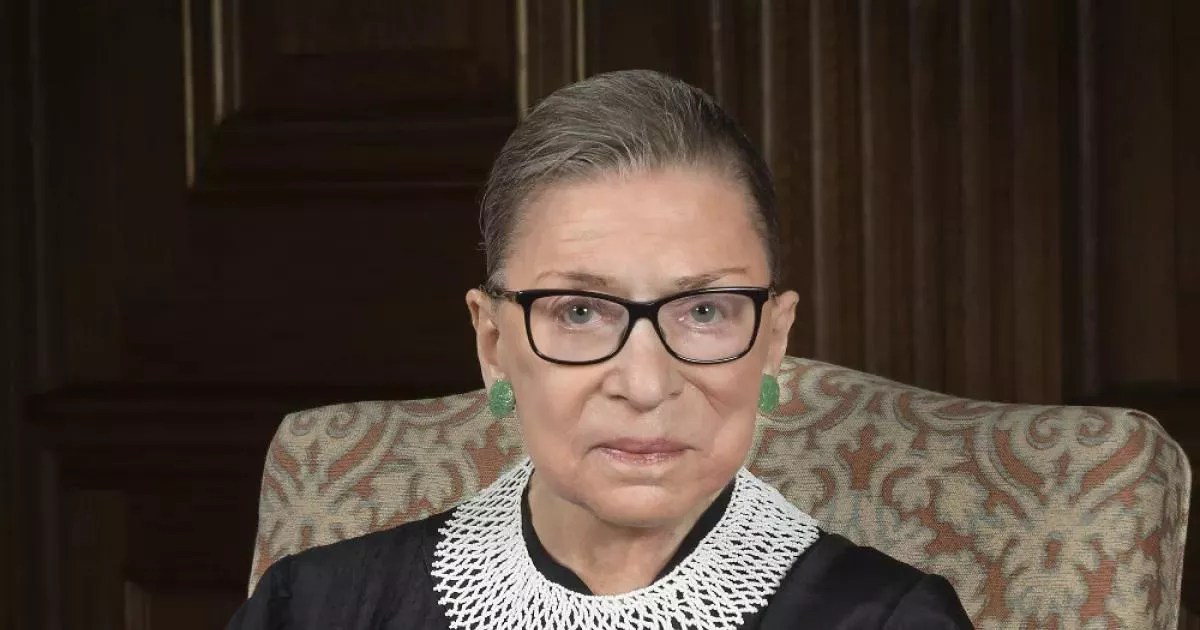From career breakthroughs to professional milestones, explore how Ruth Bader Ginsburg made an impact.
Ruth Bader Ginsburg was an American lawyer and Supreme Court Justice from 1993 until her death in 2020. Appointed by President Bill Clinton, she was the second woman and first Jewish woman to serve on the Court. Initially viewed as a moderate, she authored key majority opinions like United States v. Virginia. Later, her passionate dissents on the Court's rightward shift gained her the popular nickname "the Notorious R.B.G." Ginsburg became a cultural icon, admired for her sharp legal mind and unwavering commitment to gender equality and civil rights.
1960: Rejection by Justice Frankfurter
In 1960, Ruth Bader Ginsburg was rejected for a clerkship by Supreme Court Justice Felix Frankfurter due to her gender, despite a strong recommendation, highlighting the gender-based challenges she faced early in her career. Later that year she began clerking for Judge Palmieri.
1961: Research Associate at Columbia Law School
From 1961, Ruth Bader Ginsburg served as a research associate at the Columbia Law School Project on International Procedure, contributing to her growing expertise in law.
1963: Associate Director at Columbia Law School
In 1963, Ruth Bader Ginsburg became the associate director of the Columbia Law School Project on International Procedure, indicating her increasing prominence in legal scholarship.
1963: Professor at Rutgers Law School
In 1963, Ruth Bader Ginsburg began her career as a professor at Rutgers Law School, marking her entry into academia. She was paid less than her male colleagues.
1965: Voting Rights Act of 1965
In 2013, Ginsburg dissented in Shelby County v. Holder, in which the Court held unconstitutional the part of the Voting Rights Act of 1965 requiring federal preclearance before changing voting practices.
1969: Tenure at Rutgers Law School
In 1969, Ruth Bader Ginsburg received tenure at Rutgers Law School, acknowledging her contributions and solidifying her position in academia.
1970: Co-founded Women's Rights Law Reporter
In 1970, Ruth Bader Ginsburg co-founded the Women's Rights Law Reporter, the first law journal in the U.S. to focus exclusively on women's rights, marking a significant step in her advocacy for gender equality.
1971: Reed v. Reed
In 1971, Ginsburg cited two German cases in her first argument before the Court, Reed v. Reed, advocating for the use of foreign law and norms to shape U.S. law.
1972: Argued Moritz v. Commissioner
In 1972, Ruth Bader Ginsburg argued before the 10th Circuit in Moritz v. Commissioner on behalf of a man who had been denied a caregiver deduction because of his gender.
1972: Professor at Columbia Law School
In 1972, Ruth Bader Ginsburg began teaching at Columbia Law School, becoming its first tenured woman and expanding her influence in legal education.
1972: Co-founded the Women's Rights Project at the ACLU
In 1972, Ruth Bader Ginsburg co-founded the Women's Rights Project at the American Civil Liberties Union (ACLU), solidifying her commitment to advocating for gender equality through legal channels.
1972: End of Professorship at Rutgers Law School
In 1972, Ruth Bader Ginsburg concluded her time as a professor at Rutgers Law School, after teaching mainly civil procedure and after having received tenure in 1969.
1973: Became General Counsel of the Women's Rights Project
In 1973, Ruth Bader Ginsburg became the General Counsel for the ACLU's Women's Rights Project, taking on a leadership role in advancing women's rights through legal advocacy.
1973: Argued in Frontiero v. Richardson
In 1973, as amicus, Ruth Bader Ginsburg argued in Frontiero v. Richardson, challenging a statute that made it more difficult for a female service member to claim increased housing allowance for her husband. The Supreme Court ruled in Frontiero's favor.
1973: Challenge to Involuntary Sterilization
In 1973, the same year Roe v. Wade was decided, Ruth Bader Ginsburg filed a federal case to challenge involuntary sterilization, suing members of the Eugenics Board of North Carolina on behalf of Nial Ruth Cox, a mother who had been coercively sterilized.
1974: Participation in Gender Discrimination Cases
By 1974, the Women's Rights Project and related ACLU projects had participated in more than 300 gender discrimination cases, demonstrating Ginsburg's and the organization's extensive efforts in this area.
1975: Argued in Weinberger v. Wiesenfeld
In 1975, Ruth Bader Ginsburg represented a widower denied survivor benefits under Social Security in Weinberger v. Wiesenfeld, arguing that the statute discriminated against male survivors of workers. The court ruled in her favor.
1976: Arguments Before the Supreme Court
Between 1973 and 1976, Ruth Bader Ginsburg argued six gender discrimination cases before the Supreme Court as the director of the ACLU's Women's Rights Project, winning five of them and strategically advancing gender equality law.
1976: Craig v. Boren Argument
In 1976, Ruth Bader Ginsburg filed an amicus brief and sat with counsel at oral argument for Craig v. Boren, challenging an Oklahoma statute that set different minimum drinking ages for men and women.
1977: Fellow at the Center for Advanced Study in the Behavioral Sciences
From 1977 to 1978, Ruth Bader Ginsburg was a fellow of the Center for Advanced Study in the Behavioral Sciences at Stanford University, enhancing her understanding of the intersections between law and behavior.
1978: End of Fellowship at the Center for Advanced Study in the Behavioral Sciences
From 1977 to 1978, Ruth Bader Ginsburg was a fellow of the Center for Advanced Study in the Behavioral Sciences at Stanford University, ending her fellowship.
1978: Omnibus Judgeship Act
In 1978, Congress passed the Omnibus Judgeship Act, which increased the number of federal judges by 117 in district courts and 35 in circuit courts. The law prioritized the inclusion of women and minority groups among the judges, aligning with President Jimmy Carter's agenda. The nomination process was also required to consider the character and experience of the candidates.
January 1979: Questionnaire for U.S. Court of Appeals
In January 1979, Ruth Bader Ginsburg completed questionnaires for potential nominations to the U.S. Court of Appeals for both the Second Circuit and the District of Columbia Circuit, marking a significant step towards her judicial career.
1979: Duren v. Missouri Argument
In 1979, Ruth Bader Ginsburg's last case as an attorney before the Supreme Court was Duren v. Missouri, challenging the validity of voluntary jury duty for women.
April 14, 1980: Nomination to U.S. Court of Appeals
On April 14, 1980, President Jimmy Carter nominated Ruth Bader Ginsburg to a seat on the DC Circuit of the U.S. Court of Appeals, filling the vacancy created by Judge Harold Leventhal's death.
June 18, 1980: Confirmation to U.S. Court of Appeals
On June 18, 1980, Ruth Bader Ginsburg was confirmed by the United States Senate and received her commission to serve on the DC Circuit of the U.S. Court of Appeals.
1980: Appointment to the U.S. Court of Appeals
In 1980, Jimmy Carter appointed Ruth Bader Ginsburg to the U.S. Court of Appeals for the District of Columbia Circuit, marking an important step in her judicial career.
1980: End of Professorship at Columbia Law School
In 1980, Ruth Bader Ginsburg concluded her time as a professor at Columbia Law School, after co-authoring the first law school casebook on sex discrimination and after teaching the first legal seminar on sex discrimination.
1980: Appointment to the Federal Bench
In 1980, Ruth Bader Ginsburg was appointed to the Federal Bench, marking the end of her work on the ACLU's Women's Rights Project.
1990: Americans with Disabilities Act
In 1999, Ginsburg wrote the majority opinion in Olmstead v. L.C., in which the Court ruled that mental illness is a form of disability covered under the Americans with Disabilities Act of 1990.
June 22, 1993: Nomination to Supreme Court
On June 22, 1993, President Bill Clinton nominated Ruth Bader Ginsburg as an associate justice of the Supreme Court to fill the seat vacated by retiring Justice Byron White. She was recommended by Janet Reno, the U.S. Attorney General, and was seen as a moderate consensus-builder. Ginsburg became the first Jewish justice since 1969 and the second female justice.
August 3, 1993: Senate Confirmation
On August 3, 1993, the United States Senate confirmed Ruth Bader Ginsburg to the Supreme Court by a vote of 96-3.
August 5, 1993: Supreme Court Commission
On August 5, 1993, Ruth Bader Ginsburg received her commission as a Justice of the Supreme Court.
August 9, 1993: End of service on DC Circuit
On August 9, 1993, Ruth Bader Ginsburg's service on the DC Circuit ended due to her appointment to the United States Supreme Court. Judge David S. Tatel replaced her on the court.
August 10, 1993: Judicial Oath
On August 10, 1993, Ruth Bader Ginsburg took her judicial oath, officially beginning her service as a Justice of the Supreme Court.
1993: Appointment to the Supreme Court
In 1993, Ruth Bader Ginsburg was appointed to the Supreme Court, where she served until 2020.
1996: United States v. Virginia
In 1996, Ginsburg authored the Court's opinion in United States v. Virginia, 518 U.S. 515, which struck down the Virginia Military Institute's (VMI) male-only admissions policy for violating the Equal Protection Clause of the Fourteenth Amendment.
January 20, 1997: Administered Oath of Office to Al Gore
On January 20, 1997, Ginsburg administered the oath of office to Vice President Al Gore for a second term during the second inauguration of Bill Clinton. She was the third woman to administer an inaugural oath of office.
1997: Strate v. A-1 Contractors Opinion
In 1997, Ginsburg wrote the majority opinion in Strate v. A-1 Contractors against tribal jurisdiction over tribal-owned land in a reservation, a decision criticized by scholars of Indian law.
1999: Olmstead v. L.C. Opinion
In 1999, Ginsburg wrote the majority opinion in Olmstead v. L.C., in which the Court ruled that mental illness is a form of disability covered under the Americans with Disabilities Act of 1990.
1999: Authored Majority Opinion in Olmstead v. L.C.
In 1999, Justice Ginsburg authored the majority opinion in the Supreme Court case Olmstead v. L.C., adding to her legacy of significant legal contributions.
2000: Friends of the Earth, Inc. v. Laidlaw Environmental Services, Inc.
In 2000, Ginsburg wrote the majority opinion in Friends of the Earth, Inc. v. Laidlaw Environmental Services, Inc., in which the Court held that residents have standing to seek fines for an industrial polluter that affected their interests and that is able to continue doing so.
2000: Authored Majority Opinion in Friends of the Earth, Inc. v. Laidlaw Environmental Services, Inc.
In 2000, Justice Ginsburg authored the majority opinion in the Supreme Court case Friends of the Earth, Inc. v. Laidlaw Environmental Services, Inc., further solidifying her influence on environmental law.
2000: Stenberg v. Carhart Ruling
In 2000, Ruth Bader Ginsburg joined the Court's opinion striking down Nebraska's partial-birth abortion law in Stenberg v. Carhart, 530 U.S. 914.
June 27, 2002: Board of Education v. Earls Dissent
On June 27, 2002, Justice Ginsburg dissented in Board of Education v. Earls, criticizing the policy of mandatory drug testing for students in extracurricular activities when the school district had not identified a significant drug risk among the students or in the school.
2003: Grutter v. Bollinger Concurring Opinion
In 2003, Ginsburg noted in her concurring opinion in Grutter v. Bollinger that there was accordance between the notion that affirmative action admissions policies would have an end point and agrees with international treaties designed to combat racial and gender-based discrimination.
2003: Gratz v. Bollinger Dissent
In 2003, Ginsburg wrote in favor of affirmative action in her dissent in Gratz v. Bollinger, arguing that government decisionmakers may properly distinguish between policies of exclusion and inclusion.
May 31, 2005: Cutter v. Wilkinson Majority Opinion
On May 31, 2005, Justice Ginsburg wrote the majority opinion in Cutter v. Wilkinson, holding that facilities receiving federal funds cannot deny prisoners accommodations necessary for practicing their religious beliefs, affirming that RLUIPA was a valid accommodation under the First Amendment.
December 2005: Wagnon v. Prairie Band Potawatomi Nation Dissent
In December 2005, Ginsburg dissented in Wagnon v. Prairie Band Potawatomi Nation, arguing that a state tax on fuel sold to Potawatomi retailers would impermissibly nullify the Prairie Band Potawatomi Nation's own tax authority.
2005: City of Sherrill v. Oneida Indian Nation Opinion
In 2005, Ginsburg cited the doctrine of discovery in the majority opinion of City of Sherrill v. Oneida Indian Nation of New York, concluding that the Oneida Indian Nation could not revive its ancient sovereignty over its historic land.
2005: Authored Majority Opinion in City of Sherrill v. Oneida Indian Nation of New York
In 2005, Justice Ginsburg authored the majority opinion in the Supreme Court case City of Sherrill v. Oneida Indian Nation of New York, showcasing her continued role in shaping legal precedents.
2006: Only Female Justice on the Supreme Court
In 2006, following Sandra Day O'Connor's retirement, Ruth Bader Ginsburg became the only female justice on the Supreme Court, a position she held until 2009.
2006: Only Female Justice
In 2006, following Sandra Day O'Connor's retirement, Ruth Bader Ginsburg became the only serving female justice on the Supreme Court, which increased her public profile.
2007: Dissent in Ledbetter v. Goodyear
In 2007, Justice Ginsburg dissented in Ledbetter v. Goodyear, 550 U.S. 618, criticizing the Court's interpretation of the statute of limitations in pay discrimination cases and calling on Congress to amend Title VII of the Civil Rights Act of 1964. This case addressed plaintiff Lilly Ledbetter's claim of pay discrimination based on her gender.
2007: Dissent in Ledbetter v. Goodyear Tire & Rubber Co.
In 2007, Justice Ginsburg voiced a forceful dissent in the Supreme Court case Ledbetter v. Goodyear Tire & Rubber Co., highlighting her evolving approach to legal arguments.
2007: Gonzales v. Carhart Dissent
In 2007, Ruth Bader Ginsburg dissented in Gonzales v. Carhart, 550 U.S. 124, disagreeing with the majority's decision to uphold restrictions on partial birth abortion and criticizing Congress's findings and their veracity.
2008: Plains Commerce Bank v. Long Family Land & Cattle Co. Dissent
In 2008, Ginsburg dissented in part in Plains Commerce Bank v. Long Family Land & Cattle Co., arguing that the tribal court of the Cheyenne River Lakota Nation had jurisdiction over the case.
January 26, 2009: Arizona v. Johnson Opinion
On January 26, 2009, Ginsburg wrote the unanimous court opinion in Arizona v. Johnson, stating that a police officer may pat down an individual during a traffic stop if the officer has reasonable suspicion that the individual is armed and dangerous, based on past opinions such as Terry v. Ohio.
2009: Herring v. United States Dissent
In 2009, Ginsburg dissented in Herring v. United States, 555 U.S. 135, disagreeing with the Court's decision not to suppress evidence due to a police officer's failure to update a computer system. She viewed suppression as a remedy for Fourth Amendment violations to preserve judicial integrity and protect civil rights.
2009: Safford Unified School District v. Redding Influence
In 2009, Ginsburg was credited with influencing her colleagues in Safford Unified School District v. Redding, 557 U.S. 364, which held that a school went too far in ordering a 13-year-old female student to strip to her bra and underpants for a drug search. Ginsburg expressed that some colleagues did not fully appreciate the impact of a strip search on a 13-year-old girl.
2009: Sonia Sotomayor Appointed to Supreme Court
In 2009, Sonia Sotomayor was appointed to the Supreme Court, ending Ruth Bader Ginsburg's tenure as the sole female justice on the court.
June 28, 2010: Christian Legal Society v. Martinez Majority Opinion
On June 28, 2010, Ginsburg wrote the majority opinion in Christian Legal Society v. Martinez, ruling that a religious-based group's exclusionary membership policy conflicted with a campus's "all-comers" policy, thus the campus was not legally obligated to officially recognize the group.
August 2010: Ginsburg's Statement on Retirement
In August 2010, Ginsburg stated in an interview that her work on the Court was helping her cope with the death of her husband and expressed a wish to emulate Justice Louis Brandeis's service of nearly 23 years.
January 2012: Visit to Egypt
In January 2012, Ginsburg visited Egypt for discussions with judges, law school faculty, law school students, and legal experts, and advocated for safeguarding basic human rights in a new constitution.
2013: Shelby County v. Holder Dissent
In 2013, Ginsburg dissented in Shelby County v. Holder, writing that "Throwing out preclearance when it has worked and is continuing to work to stop discriminatory changes is like throwing away your umbrella in a rainstorm because you are not getting wet."
2013: Obama's Meeting with Ginsburg
In 2013, President Barack Obama met with Ginsburg in the White House to discuss her potential retirement, but she refused to step down.
2013: Decision Not to Retire
In 2013, despite facing health challenges and public encouragement from liberal legal scholars, Ruth Bader Ginsburg decided not to retire, choosing to continue her service on the Supreme Court.
2014: Continued Service on the Supreme Court
In 2014, Ruth Bader Ginsburg again decided against retiring from the Supreme Court, despite calls for her to do so, ensuring her continued influence on the court's decisions.
April 21, 2015: Rodriguez v. United States Opinion
On April 21, 2015, Ginsburg authored the majority opinion in Rodriguez v. United States, stating that an officer may not extend a standard traffic stop to conduct a search with a detection dog without independent reasonable suspicion of a separate crime.
April 2016: Ginsburg's Achieves Brandeis's Service Length
In April 2016, Ginsburg achieved Justice Louis Brandeis's service length of nearly 23 years on the Supreme Court.
2016: Whole Woman's Health v. Hellerstedt Concurrence
In 2016, Ruth Bader Ginsburg joined the majority and authored a concurring opinion in Whole Woman's Health v. Hellerstedt, 579 U.S. 582, which struck down parts of a 2013 Texas law regulating abortion providers. She criticized the legislation as aimed at impeding women's access to abortions rather than protecting their health.
2016: Trump's Victory and Ginsburg's Decision
In 2016, lawyer Linda Hirshman believed Ginsburg was waiting for Hillary Clinton to win the presidential election before retiring. After Trump's victory, she would have had to wait until at least 2021 for a Democrat to be president.
2020: McGirt v. Oklahoma Ruling
In 2020, Ginsburg joined the ruling of McGirt v. Oklahoma, which affirmed Native American jurisdictions over reservations in much of Oklahoma.
2020: End of Supreme Court Tenure
In 2020, Ruth Bader Ginsburg's tenure on the Supreme Court ended.
2021: Potential Waiting Period
In 2016, after Trump's victory, she would have had to wait until at least 2021 for a Democrat to be president, but died in office in September 2020.
Mentioned in this timeline

Donald John Trump is an American politician media personality and...

Bill Clinton the nd U S President - served as...

Barack Obama the th U S President - was the...
Lego is a line of plastic construction toys created by...
Saturday Night Live SNL is a late-night live sketch comedy...

Stephen Colbert is an American comedian writer producer political commentator...
Trending

Eugenio Derbez is a highly successful Mexican actor and comedian renowned for his work in both Spanish and English language...

2 months ago Angela Bassett As Queen Ramonda Stuns At Vogue World 2025; Black Panther Tribute.

8 months ago Tesla Board Initiated CEO Search to Replace Elon Musk Amidst Leadership Concerns.

9 months ago Milo Manheim and Liz Gillies bond in Little Shop of Horrors, extend run.

1 month ago Alexander Skarsgård reminds Miriam Margolyes of their meeting; addresses sexuality question, states 'not really' gay.

2 months ago Jeremy Renner faces accusations of ICE threat and misconduct controversy in Hollywood.
Popular

Stranger Things created by the Duffer Brothers is a popular...

XXXTentacion born Jahseh Dwayne Ricardo Onfroy was a controversial yet...

Kelsey Grammer is an accomplished American actor producer and singer...

Candace Owens is an American conservative political commentator and author...

Bernie Sanders is a prominent American politician currently serving as...

Melania Trump a Slovenian-American former model has served as First...
